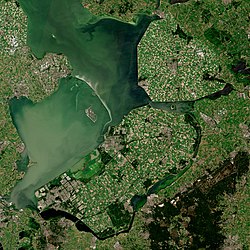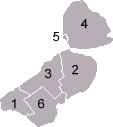Flevoland
This article needs additional citations for verification. (April 2010) |
Flevoland | |
|---|---|
|
| |
| Anthem: "Waar wij steden doen verrijzen..." "Where we make cities arise..." | |
 Location of Flevoland in the Netherlands | |
 | |
| Coordinates: 52°32′N 5°40′E / 52.533°N 5.667°E | |
| Country | |
| Inclusion | 1986 |
| Capital | Lelystad |
| Largest city | Almere |
| Government | |
| • King's Commissioner | Leen Verbeek (PvdA) |
| • Council | States of Flevoland |
| Area (2017)[1] | |
| • Total | 2,412 km2 (931 sq mi) |
| • Land | 1,412 km2 (545 sq mi) |
| • Water | 1,000 km2 (400 sq mi) |
| • Rank | 10th |
| Population (1 January 2020)[2] | |
| • Total | 423,021 |
| • Rank | 11th |
| • Density | 299/km2 (770/sq mi) |
| • Rank | 8th |
| ISO 3166 code | NL-FL |
| HDI (2018) | 0.912[3] very high · 9th |
Flevoland (UK: /ˈfleɪvoʊlænd/,[4] US: /ˈfliːv-, ˈflɛv-/,[5][6] Dutch: [ˈfleːvoːlɑnt] ) is the 12th and youngest province of the Netherlands, established in 1986, when the southern and eastern Flevopolders were merged into one provincial entity. It is in the centre of the country, against the freshwater IJsselmeer and Markermeer, until 1932 a natural harbour, the Zuiderzee. Almost all of the land belonging to Flevoland was reclaimed from those meres in the 1950s and 1960s.[7] As to dry land, it is the smallest province of the Netherlands at 1,412 km2 (545 sq mi), but not gross land as that includes much of the waters of the fresh water lakes (meres) mentioned.[8] The province has a population of 423,021[8] as of January 2020 and consists of six municipalities. Its capital is Lelystad and its most populous city is Almere.
Flevoland is bordered in the extreme north by Friesland, in the northeast by Overijssel, and in the northwest by the lakes Markermeer and IJsselmeer. In the southeast, the province borders on Gelderland, and in the southwest on Utrecht and North Holland.
Etymology
Flevoland was named after Lacus Flevo, a name recorded in Roman sources for a large inland lake at the southern end of the later-formed Zuiderzee; it was mentioned by the Roman geographer Pomponius Mela in his De Chorographia in 44 AD. Due to the slowly rising sea level, a number of lakes gradually developed in the Zuiderzee region, which eventually became contiguous. Pomponius wrote about this: "The northern branch of the Rhine extends to Lake Flevo, which encloses an island of the same name and then flows to the sea like a normal river." Other sources speak of Flevum, which means 'flow'. The process continued and gradually the Zuiderzee arose from this lake. The names "Flevoland" and "Vlieland" have the same origin. Between 790 and 1250, Lake Flevo became connected with the North Sea. As a result, a number of villages were swallowed by the sea. The newly created inland sea was called Almere. The city of Almere is named after this lake.
History
After a flood in 1916, the decision was made to enclose and reclaim the Zuiderzee, an inland sea within the Netherlands, and thus the Zuiderzee Works started. Other sources[9] indicate other times and reasons, but also agree that in 1932, the Afsluitdijk was completed, which closed off the sea completely. The Zuiderzee was later divided into IJsselmeer (mere at the end of the river IJssel) and Markermeer, planned to be mostly drained to make the Markerwaard. The Markerwaard was never built due to post-War fiscal austerity.
The first land reclaimed was the northeast polder (Noordoostpolder) in 1942. This took in the former small islands Urk and Schokland. It was at first added to the Province of Overijssel.
In the southwest the Flevopolder – larger than the above – was then reclaimed; its southeast half in 1957 and other parts by 1968.
An key feature of the latter was a narrow body of water, kept at 3 metres below sea level, was preserved along the old coastline to stabilise the water table and to prevent coastal places from losing association with the sea. Thus, the Flevopolder became an artificial island joined to the mainland by bridges. The municipalities on the three parts voted to become a province, shortly before this was effected in 1986.
Geography
Zuiderzee Works



Eastern Flevoland (Oostelijk Flevoland or Oost-Flevoland) and Southern Flevoland (Zuidelijk Flevoland or Zuid-Flevoland), unlike the Noordoostpolder, have broad channel between them and the mainland: the Veluwemeer and Gooimeer, respectively, making them, together, the world's largest artificial island.
They are two polders with a joint hydrological infrastructure, with a dividing dike in the middle, the Knardijk, that will keep one polder safe if the other is flooded. The two main drainage canals that traverse the dike can be closed by floodgates in such an event. The pumping stations are the Wortman (diesel powered) at Lelystad-Haven, the Lovink near Harderwijk on the eastern dike and the Colijn (both electrically powered) along the northern dike beside the Ketelmeer.
A new element in the design of Eastern Flevoland is the larger city Lelystad (1966), named after Cornelis Lely, the man who had played a crucial role in designing and realising the Zuiderzee Works. Other more conventional settlements already existed by then; Dronten, the major local town, was founded in 1962, followed by two smaller satellite villages, Swifterbant and Biddinghuizen, in 1963. These three were incorporated in the new municipality of Dronten on 1 January 1972.
Southern Flevoland has only one pumping station, the diesel-powered De Blocq van Kuffeler. Because of the hydrological union of the two Flevolands, it simply joins the other three in maintaining the water level of both polders. Almere relieves the housing shortage and increasing overcrowding on the old land. Its name is derived from the early medieval name for Lake Almere. Almere was to be divided into three major settlements initially; the first, Almere-Haven (1976) situated along the coast of the Gooimeer (one of the peripheral lakes), the second and largest was to fulfill the role of city centre as Almere-Stad (1980), and the third was Almere-Buiten (1984) to the northwest towards Lelystad. In 2003, the municipality made a new Structuurplan which started development of three new settlements: Overgooi in the southeast, Almere-Hout in the east, and Almere-Poort in the West. In time, Almere-Pampus could be developed in the northwest, with possibly a new bridge over the IJmeer towards Amsterdam.
The Oostvaardersplassen is a landscape of shallow pools, islets, and swamps. Originally, this low part of the new polder was destined to become an industrial area. Spontaneous settlement of interesting flora and fauna turned the area into a nature park, of such importance that the new railway line was diverted. The recent decline in agricultural land use will in time make expanding natural land use possible, and connect the Oostvaardersplassen to the Veluwe.
The centre of the polder most closely resembles the prewar polders in that it is almost exclusively agricultural. In contrast, the southeastern part is dominated by extensive forests. Here is also found the only other settlement of the polder, Zeewolde (1984), again a more conventional town acting as the local centre. Zeewolde became a municipality at the same time as Almere on 1 January 1984, which in the case of Zeewolde meant that the municipality existed before the town itself, with only farms in the surrounding land to be governed until the town started to grow.
Municipalities
 |
Politics

The King's Commissioner of Flevoland is Leen Verbeek,[10] who is a member of the Labour Party (Netherlands) (PvDA). The States of Flevoland have 41 seats. At the provincial elections in March 2019, Forum for Democracy was the big winner of the elections. The party came new in the States with 8 seats, and is with those the biggest party. The People's Party for Freedom and Democracy is second largest with 6 seats, after which the Party for Freedom and GreenLeft both have 4 seats. Christian Democratic Appeal, Labour Party, and ChristianUnion all have 3 seats. Socialist Party, 50PLUS, Democrats 66 and Party for the Animals have 2 seats, where the Reformed Political Party and Denk, another new party in the States, have 1 seat.[11]
Economy
The Gross domestic product (GDP) of the province was 14 billion € in 2018, accounting for 1.8% of the Netherlands economic output. GDP per capita adjusted for purchasing power was 29,500 € or 98% of the EU27 average in the same year.[12]
Transport
Rail


The Flevopolder is served by the Flevolijn, running from Weesp to Lelystad, and the Hanzelijn, continuing from Lelystad towards Zwolle. The two railways stations of the province with intercity services are Almere Centrum and Lelystad Centrum.
| Trajectory | Railway stations in Flevoland |
|---|---|
| Weesp–Lelystad | North Holland – Almere Poort – Almere Muziekwijk – Almere Centrum – Almere Parkwijk – Almere Buiten – Almere Oostvaarders – Lelystad Centrum |
| Lelystad–Zwolle | Lelystad Centrum – Dronten – Overijssel |
Furthermore, Lelystad Zuid is a planned railway station between Almere Oostvaarders and Lelystad Centrum. It has been partially constructed preceding the opening of the railway in 1988, but construction has been put on indefinite hold because of slower-than-expected development of the city of Lelystad.
Amongst the cities with direct train connections to Flevoland are Amsterdam, Utrecht, The Hague, Zwolle, Groningen, Leeuwarden and Schiphol Airport.
Airport
There is one airport in the province: Lelystad Airport. A second airport, Noordoostpolder Airport near Emmeloord, was closed in the late 1990s due to town expansion.
Events
References
- ^ "Oppervlakte".
- ^ "CBS Statline". opendata.cbs.nl.
- ^ "Sub-national HDI - Area Database - Global Data Lab". hdi.globaldatalab.org. Retrieved 13 September 2018.
- ^ "Flevoland". Lexico UK English Dictionary. Oxford University Press. n.d. Retrieved 21 August 2019.
- ^ "Flevoland". Collins English Dictionary. HarperCollins. Retrieved 21 August 2019.
- ^ "Flevoland". Merriam-Webster.com Dictionary. Merriam-Webster.
- ^ How it works : science and technology. New York: Marshall Cavendish. 2003. p. 1208. ISBN 0761473238.
- ^ a b "Regionale kerncijfers Nederland" [Regional key figures Netherlands]. CBS Statline (in Dutch). CBS. 17 June 2020. Retrieved 21 June 2020.
- ^ "Pagina niet gevonden". Provincie Flevoland. 21 February 2019. Archived from the original on 3 August 2013.
- ^ "Leen Verbeek". Archived from the original on 2 April 2015. Retrieved 6 March 2015.
- ^ "Uitslag Provinciale Statenverkiezingen 2019". Provincie Flevoland. 25 March 2019.
- ^ "Regional GDP per capita ranged from 30% to 263% of the EU average in 2018". Eurostat.
{{cite web}}: CS1 maint: url-status (link)
External links
- Official website
- Zuiderzee Museum
 Flevoland travel guide from Wikivoyage
Flevoland travel guide from Wikivoyage




